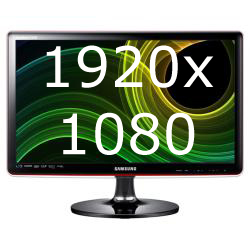 While
While  everybody else is stuck in 1080p — aka “full HD” — Apple is thinking and developing on a bigger canvas than that — starting with the new iPad‘s 2048 x 1536 screen. They are always looking to move standard usage forward by large steps (where they change the whole market and win big in the process), and you can bet they’re doing that again with display. The iPad display won’t be the last Apple one to break out of the 1080p mold.
everybody else is stuck in 1080p — aka “full HD” — Apple is thinking and developing on a bigger canvas than that — starting with the new iPad‘s 2048 x 1536 screen. They are always looking to move standard usage forward by large steps (where they change the whole market and win big in the process), and you can bet they’re doing that again with display. The iPad display won’t be the last Apple one to break out of the 1080p mold.
For a snapshot of where we are now, go shop for a computer monitor . Most of what you’ll find is 1920 x 1080: the dimensions of HDTV, and the continued embodiment of ATSC standards for TV that were adopted in the early 1990s in anticipation of the fully digital age. That age is now here, and in the process TV is getting slowly absorbed into the Internet. So, at this point in history, your computer monitor can be your TV, and vice versa. Digital movie production is also now standardized on 1080p24 (24 frames per second) standard. So it looks like everything is settled, right? Well, I am sure Steve Jobs and friends looked at that situation several years ago and saw “stuck” instead of “settled.” The new iPad is the first clear clue that this was the case.
In the long roster of display resolutions, the iPad’s dimensions are QXGA, which is among the breed of 3×4 resolutions. 1080p is 16×9. What matters here, however, isn’t the standard being used, or the dimensions, but breaking out of a currently defaulted (or stuck) mode.
The main question for me is whether or not Apple will succeed in building a walled garden for everything new that breaks out of the old 1080p mold. I doubt they’ll succeed, but I’ll bet they’ll try.
(Oh, and in case you doubt my prophetic powers regarding Apple, check out what I wrote to Dave Winer in 1997.)
Leave a Reply